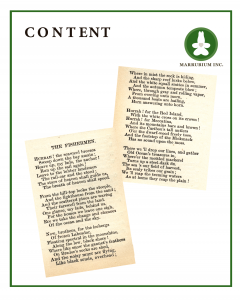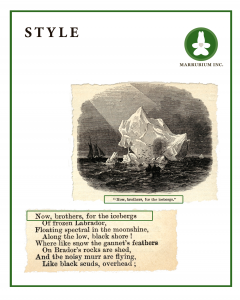The Matt Rouge Writing Model
The panel graphics are derived from an 1888 volume of John Greenleaf Whittier’s complete poems; the poem is The Fishermen. Click on a thumbnail for a larger image.
INTRODUCTION
In any writing project, there are four areas in which a writer adds value: context, content, structure, and style. In general, a writer develops a piece by focusing on the areas in that order, since context is the most fundamental, content and structure are about equally fundamental, and style is the least fundamental. A writer must be prepared, however, to consider all four areas from the beginning of the project and move flexibly between them at every stage.
The writer first needs to understand the actual situation about which he or she will be writing: not just the raw facts, but also the thoughts and emotions of the people involved. It’s usually necessary to do a bit of research and conduct some interviews.
Further, advertising and PR writing is promotion, one of the four P’s of marketing (product, price, promotion, place/distribution), each of which is a major element of the project’s context:
- What is the product (good, service, event, cause, candidacy, etc.)? What are its attributes? How do people feel about the product? How do we want people to feel about the product? How successful is the product? How successful are competing products? What are the advantages and disadvantages of the product versus the competition?
- How expensive is the product? Is its positioning premium or discount?
- What messages about the product have been put “out there” by the company or others? Are there certain words or phrases that we need to use when describing the product (“canon”)?
- How will people access the product?
As a marketing MBA, I add considerable value in the area of context by helping a company understand its competitive situation and how it relates to current and prospective marketing messages.
Having understood the situation at hand, the writer must decide what specific messages (facts and opinions) to include in the piece. The choices are infinite but the space and time available are decidedly finite.
In many cases, the client specifies the general content; in others, the writer or the client’s ad agency provides ideas. Either way, the writer must perform a variety of tasks to assemble and create the specific content. The following are just a few possibilities:
- Create an outline of what to include.
- Assemble preexisting, approved messages from other sources for reuse (websites, newsletters, ads, press releases, white papers, studies, manuals, etc.).
- Conduct interviews to develop new information or quotes.
- Research facts and note sources.
I take a proactive, value-adding approach to content assembly and creation, assessing a company’s message resources and using them at their fullest potential.
A writing project always begins with a general structure in mind: a website, a print ad, a newsletter, etc. Good writers maximize the potential of the macro structure while creating micro structures that help get the message across.
Standard structures look and feel a certain way, and good writers fulfill readers’ expectations, making sure that nothing seems odd or out of place. Consider what a writer does in each of the following:
- Press release. Organize an effective who/what/where/when/how first paragraph.
- Website. Write a homepage intro that succinctly conveys the value proposition.
- Blog. Write a short (but not too short) post that delivers the intended marketing message and uses the desired keywords.
- Video script. Craft dialog and narration that flows well and matches the time parameters precisely.
These are just a few examples. My extensive experience in every type of commercial writing allows me to add considerable value by fulfilling readers’ expectations while innovating for extra interest and appeal.
At last the writer pens or types actual words in a style appropriate to the piece. A press release, a direct mail card, and a homepage intro all have a different cadence and flow. The writer must impart a style that seems both familiar and fresh and helps convey a message effectively.
With experience writing advertising and PR in a wide variety of styles, from soft and fluffy (see Baby-G ad) to dry and technical, I can write copy for you that appeals to your readers and helps sell your products.
CONCLUSION
This model is a simple but powerful tool that helps me take a holistic approach to a writing project while adding value in four distinct areas. Armed with this model and extensive experience, I will create marketing materials for you that will engage, educate, and influence your readers.




